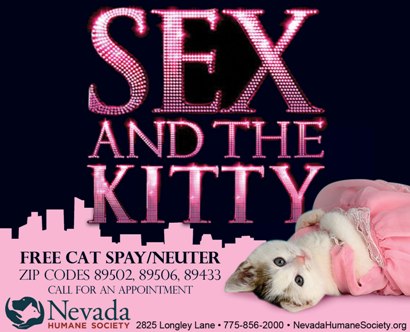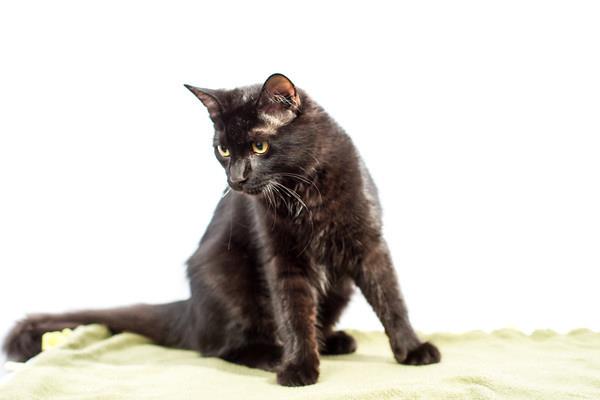How to get more cats adopted
The following tips on how to increase cat adoptions are from Bonney Brown, former executive director of the Nevada Humane Society. I attended her presentation on saving shelter cats at the 2012 No Kill Conference. This post is not intended as an outline of her presentation. These are just some of the ideas I walked away with.
The Nevada Humane Society sets a good example as a true no-kill shelter. According to Brown, it does not turn pets away, and it does not kill healthy, adoptable animals.
20 tips to get more shelter cats adopted
1. Offer reduced adoption fees or FREE cat adoptions.
“Money does not buy or ensure love,” Brown said. “Many of you have just picked up an animal, that you didn’t pay for, and loved it very much.”
She’s right. My mutt Ace was free. So was my cat, Scout.
Statistically, there is no difference in the attachment between someone who pays $75 for a cat and someone who gets the cat for free, Brown said. “You don’t really need to worry as much as you might think you would about reduced-rate adoptions.”
In fact, volunteers for the Nevada Humane Society hand out free cat-adoption coupons while out and about in the community, she said. This brings additional people to the shelter who would not have visited otherwise.
Read more on why free pet adoptions are OK.
2. ‘Pick your price.’
One man wrote a $1,000 check to the NHS when he adopted a regular tabby cat, according to Brown. You never know what people will pay if you leave it up to them. Some will pay $5. Others will pay $50.
What would you pay?
3. ‘Seniors for seniors.’
Seniors can adopt senior pets from the NHS at no cost, Brown said. And “senior” is defined loosely. Anyone 55 or older can adopt a dog or a cat age 6 or older for free. In addition, all cats over age 10 are $10 to all adopters. Dogs ages 10 and older are $25.
Read more on how to get senior pets adopted.
4. Offer excellent customer service.
Shelter staff and volunteers must be friendly with people who call or visit the shelter, Brown said. They should have the ability to laugh, to connect and have a good time. No one should enter the shelter without being greeted.
A no-brainer, right? Maybe not. We all know how high and mighty certain shelter volunteers can get. They lose compassion for people faced with difficult choices about re-homing their pets. Emails sit unanswered. Egos get in the way.
Step up the customer service, and send more kitties home.
5. Encourage potential adopters to hold and touch the cats.
It’s hard to connect with a cat who is behind bars or glass, Brown said. Cage-free housing for the cats is ideal. If that’s not an option, take the cat out of her cage and bring her to a room where the potential adopter can hold or pet her. Give adopters a chance to form a bond.
6. Promotions for black cats.
If a shelter has a lot of black cats or any other type of cat, Brown suggested promotions such as discounts on “mini panthers” or two-for-one deals. This is a great time to offer “pick your price.”
7. Two-for-one deals.
If two cats play well together and adopters see them interact, someone might be interested in adopting the pair, Brown said.
8. Help adopters see the cats’ personalities.
Allow adopters to watch how the cats play and interact with people, Brown said. This is especially important for people with kids, dogs or multi-cat families.
Make sure to point out anything you know about the cat’s personality that might not be so obvious. For example, maybe the cat likes to pounce on people’s feet or maybe the cat is very “vocal” at mealtimes. Maybe she is good with dogs.
9. Take the cats to off-site adoption events.
Sometimes people are hesitant to visit shelters because they believe shelters are depressing, Brown said. Because of this, most people obtain their cats elsewhere. One way to change this is to actually bring the cats out into the community. PetSmart is great about hosting adoption events for shelters, but you could also ask other businesses if they’d like to help.
10. Create a welcoming atmosphere.
Since people tend to avoid shelters because of poor customer service, inconvenient adoption hours or feelings of guilt, it’s up to shelters to change that.
Shelter staff and volunteers need to make sure the environment is a warm, welcoming place for adopters, Brown said. One way to do this is by decorating for different holidays and inviting the community to help. The shelter should also host fun activities and events for people of all ages.
People don’t want to be lectured about why they should adopt or why they should spay or neuter their animals, Brown said. But they’ll pay attention to fun announcements and advertisements. For example, NHS runs a “Sex and the Kitty” campaign to promote free spaying and neutering.
12. High-quality photos.
It’s hard to get good photos of cats without the right camera. But Brown suggested if shelters ask the community for help, someone will probably donate or purchase a camera for the shelter. Ask, and you shall receive.
13. Hold signs at intersections.
Signs are important for attracting new people who were previously unaware of the shelter, Brown said. They are also an easy way to promote current adoption specials.
14. Don’t allow cats to be second-class citizens to dogs.
Brown makes a point to include cats on all her shelter’s marketing materials such as the web site and on all printed materials. Cats should be included on posters, signs, ads, and newsletters.
15. Host a ‘cat show.’
Brown explained how the NHS rented a casino and held a cat convention set up as a “cat show” (think Westminster) for the community featuring about 100 of its shelter cats. The shelter invited cat-related vendors, cat-related nonprofits and of course, adopters. The event got the cats in front of people who would never visit a shelter.
16. Well-written descriptions.
Online profiles and cage cards should make it easy for people to imagine what the cats are like, Brown said. Be descriptive and honest. Point out specific info people would actually want to know such as whether or not the cat is declawed and how she acts around other pets.
Example: I love to cuddle, and I am great with kids but I have major “cattitude” around other kitties. I’m declawed, overly playful and up to date on my shots.
The following examples are also supported by true no-kill shelters in general but were not necessarily mentioned in Brown’s presentation:
17. Convenient adoption hours.
Make sure your shelter is open every single day of the week, including some evening hours when most people are available to visit the animals. Don’t sit and complain how no one is visiting the shelter when it’s only open three days per week for limited hours. Shelters need to be competing in the market or people will obtain their pets somewhere else.
Studies show people get their cats from shelters just 10 percent of the time, according to Nathan Winograd in the book Redemption. “Shelter killing is more a function of market share than ‘public irresponsibility.'”
18. Reasonable adoption criteria.
Shelter killing is the leading cause of death for healthy dogs and cats in the United States, according to the No Kill Advocacy Center.
In order to save the lives of millions of cats, we need to stop being so picky and just send them home. Of course, an adoption application with references is reasonable. So is contacting a landlord. Home visits, on the other hand, can seem too invasive for potential adopters, and the quality of a person’s home will not predict the care the animal will receive.
Let’s face it. Rescue groups have ridiculous requirements.
19. Set up a barn cat adoption program.
This is a great option for feral cats or cats with litter box issues. Animal Allies in Duluth, Minn., offers a free barn cat adoption program. The cats are spayed/neutered and vaccinated before adoption. The adopter agrees to offer the cat warm, outdoor housing and the cat will naturally handle any mice or rats.
20. Recruit additional foster homes.
If your shelter has more cats than it can handle, send out a message to the community requesting new foster homes. Chances are, some of these foster homes will end up keeping the cats permanently. I’d call that a win-win.
Shelters sometimes complain that not enough people will foster, but that’s because people are unaware of the need for cat fostering. Other shelters are killing cats for a “lack of homes” without implementing a foster program at all.
What are some additional ways to increase marketing for shelter cats?
Below is Beibs, who is up for adoption with Humane Society Fargo-Moorhead in Fargo, N.D. Cinder, above, is up for adoption with CATS Cradle Shelter in Fargo.




Maureen
Wednesday 3rd of September 2014
I love the FB idea! Not sure our shelter has one but will certainly look into it. I do not think our director is progressive:( I too was concerned about the "free" idea. Seems to be controversial. There is data out there to suggest that free animals are just as loved/ cared for as ones you pay for. Our shelter dogs cost $85 with $65 of those dollars going to spay and neutering. Do you think offering "canine spay/ neutering coupons" is a safer and less controversial option? Do you think it would have the same possible draw into the shelter that day as "free"?
Lindsay Stordahl
Wednesday 3rd of September 2014
I love the free adoption idea, but even if you can get the director to approve of dogs at a discounted adoption fee, I think that would be great! Maybe half off or something like that. And if you can't do that, then yes maybe the free or discounted spay/neuter coupons.
Maureen
Wednesday 3rd of September 2014
I wanted to get your opinion... October 25th is "Make a Difference Day" (the largest national day of community service.) My 15 year old son wants to raise money to donate to our city's animal shelter (which is a kill shelter) and provide "canine coupons" for free dogs and puppies on that day. He also wanted to offer a "2 for the price of one kitty coupons" on that day as well. At the end of the day, any extra money would be used to provide additional coupons to be used when our shelter deems appropriate/necessary. On Make a Difference Day he also wants to organize volunteers to meet at the shelter to love on the animals and to promote the coupons (maybe also do some sort of project that the shelter suggests). He is still trying to figure out how to promote this day (a downtown banner, newspaper write up etc) He is in the process of formulating his ideas to present to our shelter's director for approval. Do you see any problems with this plan? He wants to go in with a strong plan that the shelter may want to tweak but support. Any assistance would be appreciated!
Lindsay Stordahl
Wednesday 3rd of September 2014
Wow, you should be so proud of your son!
It sounds like a wonderful idea to me. A lot depends on the shelter director and how progressive he/she is. Hopefully this person knows that in order to save more dogs you have to offer these types of adoption specials, but be prepared to deal with someone who may think the idea is outrageous. Hopefully you won't have to deal with that, but just be prepared for that possibility.
The shelter might not be comfortable offering free dogs and puppies, but perhaps they would be willing to do something like $10 dogs and $50 puppies or something like that. (Not sure what they normally charge.) I love the 2-for-1 price on cats.
Perhaps the shelter could promote your son's project on its Facebook page?
Melissa
Wednesday 21st of August 2013
I actually agree with everything. I know you meant "lecture" as in talk down to people because that turns them off to you and your cause. And free adoptions are great! I'll turn around and buy pet insurance with that money I saved or a really high end scratching post. NYC does the mini black panther campaign and it works! I wasn't interested in a pet cat but I found myself looking for black cats to adopt. I just adopted a stray from a friend and the cat is totally free... Makes me open taking her in! I can afford the litter box and toys with that money. Just because she is free doesn't mean it devalues her in my eyes or will cause me to neglect or abuse her. That logic is backwards because it assumes people who can't afford or want to afford adoption fees are also uneducated or treat their pets badly. I am one of those people and I love my dog, and will love my cat, dearly.
Lindsay Stordahl
Wednesday 21st of August 2013
Your pets are so lucky to have you! Two of my pets were free as well. The other was only $25. Let's just say all three are quite spoiled!
Dan
Wednesday 21st of August 2013
Oh, Lauren.
Lauren
Wednesday 21st of August 2013
This is highly irresponsible. News flash. People do sometimes need to be educated and particularly so about spay/neuter. It is all about the delivery of that information, but without it, there would be even more homeless cats being euthanized in the world. Secondly, home visits are very important as some people think it perfectly fine to open their windows without a screen in place. I've never regretted a home visit as being unnecessary. Once a visited a home where a cat was emaciated and they wanted to adopt another. A home visit helps to ensure a cat's safety. It's not about the "quality of the home". And free adoptions brings in people who may not be able to afford vet care, or worse, may abuse an animal. You never give a cat away for free.